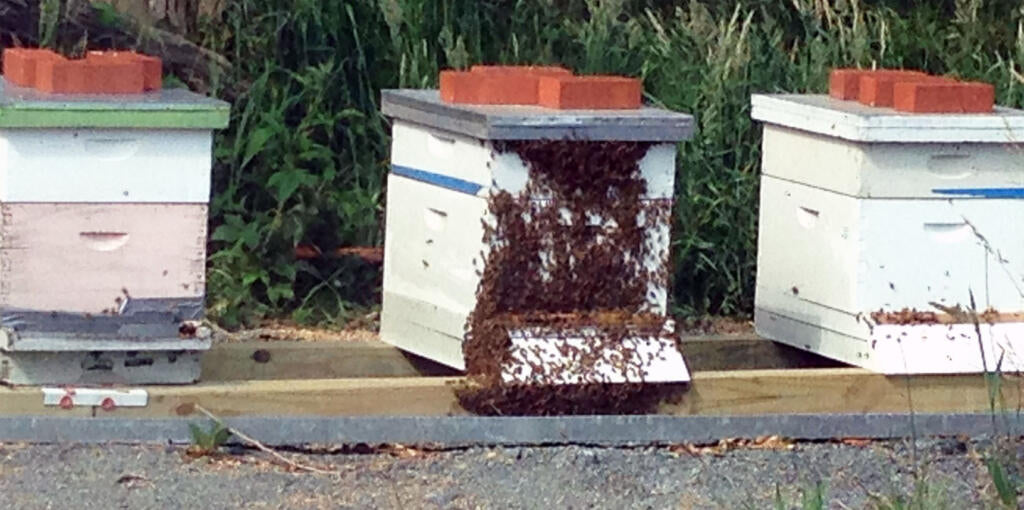Overcrowded bees swarm. Weakened colonies will swarm. Bees leave the hive and find a tree or car or toy set or whatever place they deem appropriate for a day or so until they find a new location to live. “There’s a bee for that.” As you may know, bees each have a particular role in the hive. The “Scout Bee” has the job of finding a new home for bees in overcrowded living situations. If you find a random group of tightly woven bees, they will probably be in the shape of a football hanging from a tree limb. They are usually calm when they are in a swarm. It is not difficult to collect them in an empty hive box, add a queen (if necessary) and start another hive.
The image below represents my first swarm. I was in the bee yard with my teacher Mike. The bees were VERY HIGH up in the tree, and Mike was standing at the bottom of the tree banging two drum sticks together to lure the bees into an empty hive ready for collection. The funny part: The bees weren’t coming. I left that day and looked over my shoulder to see if Mike was still banging the drumsticks together, and he was. Rest in peace, Mike; I picture you in heaven happily covered in a swarm of bees.

First Year Swarming is Unlikely
Bees need room to grow. If they are overpopulated early in the spring, they will look for a new place to spread out. If you tend bees, take inventory on capped brood and add empty frames to give the bees room to grow. This curbs swarming. Adding a perfectly timed second brood box allows the bees to climb up and spread out, offering a better chance of keeping them home.

Adding another brood box or splitting the bees using Nucleus “nuc” frames and creating another hive is like a gift for the bees and the beekeeper. Bees like to fill out frames before moving upwards into the hive. Being vigilant and staying in touch with the colony’s progress allows the beekeeper to expand at the right moments.
Last season we had an incredible start to the season.

The plant material was in full bloom early, and the bees gathered nectar early. We realized, mostly way too late (because they were a month ahead of the years before), that the brood chamber was filled with honey! There was a reduction in the workforce because the queen had no place to grow her family. Had we caught this situation in time and “checker-boarded” the brood chamber with empty frames, the bees could have kept busy, and the queen lays.

Bees may also swarm for other reasons that may have to do with disease.
Bees may leave to find a new food source because they are hungry. A mouse may have found its way into the hive causing the bees to flee. Sometimes I notice when there are sharp changes in the weather they leave, or they may swarm due to queen failure. I have heard stories where a beekeeper added a new super to a hive made from “new fresh wood,” The bees swarmed.
When you are a new bee, it’s sometimes hard to determine why your bees are gone. When a hive weakens, and the bees die off, it can appear to have swarmed when everyone just died. In my experience (I am updating this piece nine years after I originally wrote it), when weak hives get robbed by a neighboring, hungry hive, the result can appear to have been a swarm.
What Signs Do You Look for to Prevent a Swarm?
For “new-bees” like me, it’s easy to confuse “bearding” with “swarming.” “Bearding” is when many of the bees from inside the hive hang out on the OUTSIDE of the hive. The most prolific beards appear on the hottest and most humid summer days. The bees are sitting out on the front porch to keep themselves and the hive cool. The larger the population, the more you will see bearding in the hot weather. Soon, we’ll learn more about bearding.

Next post in this series: Visiting the hives on day 32


